Research
Ohkoshi laboratory are trying to open a new field of solid state chemistry by design and synthesis of novel magnets which have novel properties and functionalities. The summaries are described by the phenomena as follows.
- Long-term heat-storage ceramics absorbing thermal energy from hot water
- A new magnetic recording method using millimeter/terahertz waves
- Photoswitchable superionic conducting polar crystal
- Low pressure responsive heat storage ceramics
- Magnetization reversal by light irradiation and ultrafast magnetization response by terahertz light in magnetic tape
- Theoretical prediction of phase transitions in solid materials by computer calculation
- Discovery of a "heat-storage ceramic"
- Cesium ion detection by THz light
- Largest coercive field ferrite magnet in a crystallographically oriented film based on metal-substituted ε-iron oxide"
- Microscopy probe to observe strong magnets using rustproof ferrite bar magnet which withstands strong magnetic field and electric current
- Development of a magnetic recording tape using epsilon iron oxide
- The world's smallest hard ferrite magnet
- 90-degree optical switching of output light in the first chiral photomagnet
- Hard magnetic ferrite with gigantic coercivity and high frequency millimeter wave rotation
- Synthesis of a metal oxide with a room-temperature photoreversible phase transition
- Light-induced spin-crossover magnet
- Synthesis of metal complexes with novel magnetic functionalities
- Magnetic property in metal oxides
1. Long-term heat-storage ceramics absorbing thermal energy from hot water
We synthesized new compounds of scandium-substituted lambda trititanium pentoxide (λ-ScxTi3-xO5; x=0.09, 0.105, 0.108). Synchrotron XRD measurement revealed that the present compound has the same structure as the non-substituted λ-Ti3O5. λ-ScxTi3-xO5 has very high stability and does not change even after 367 days (1 year). When pressure was applied to λ-ScxTi3-xO5, a pressure-induced phase transition to β-ScxTi3-xO5 was observed instantaneously. Examination of heat-storage properties of the pressure-produced β phase indicated the sample with the composition of x = 0.09 showed an endothermic peak at 67 ℃, revealing that the present material absorb heat below 100 ℃. We also confirmed that the phase transition between the λ and β phases occurs repeatedly by the application of pressure and heat. Therefore, the present heat storage material can be applied to recover the thermal energy from cooling water in power plant turbines, mitigating the rise in sea water temperatures. In addition, other applications of the present material such as heat-storage usage to collect waste heat from factories, transportation vehicles, mobile phones, and electronic devices should be possible.
(Y. Nakamura, S. Ohkoshi, et al., Science Advances, (2020).)
*This topic appeared on TV asahi, Nikkei newspaper, Tokyo Newspaper, Chunichi Newspaper, Nikkan Kogyo newspaper, the Chemical Daily newspaper, the Science News, etc.
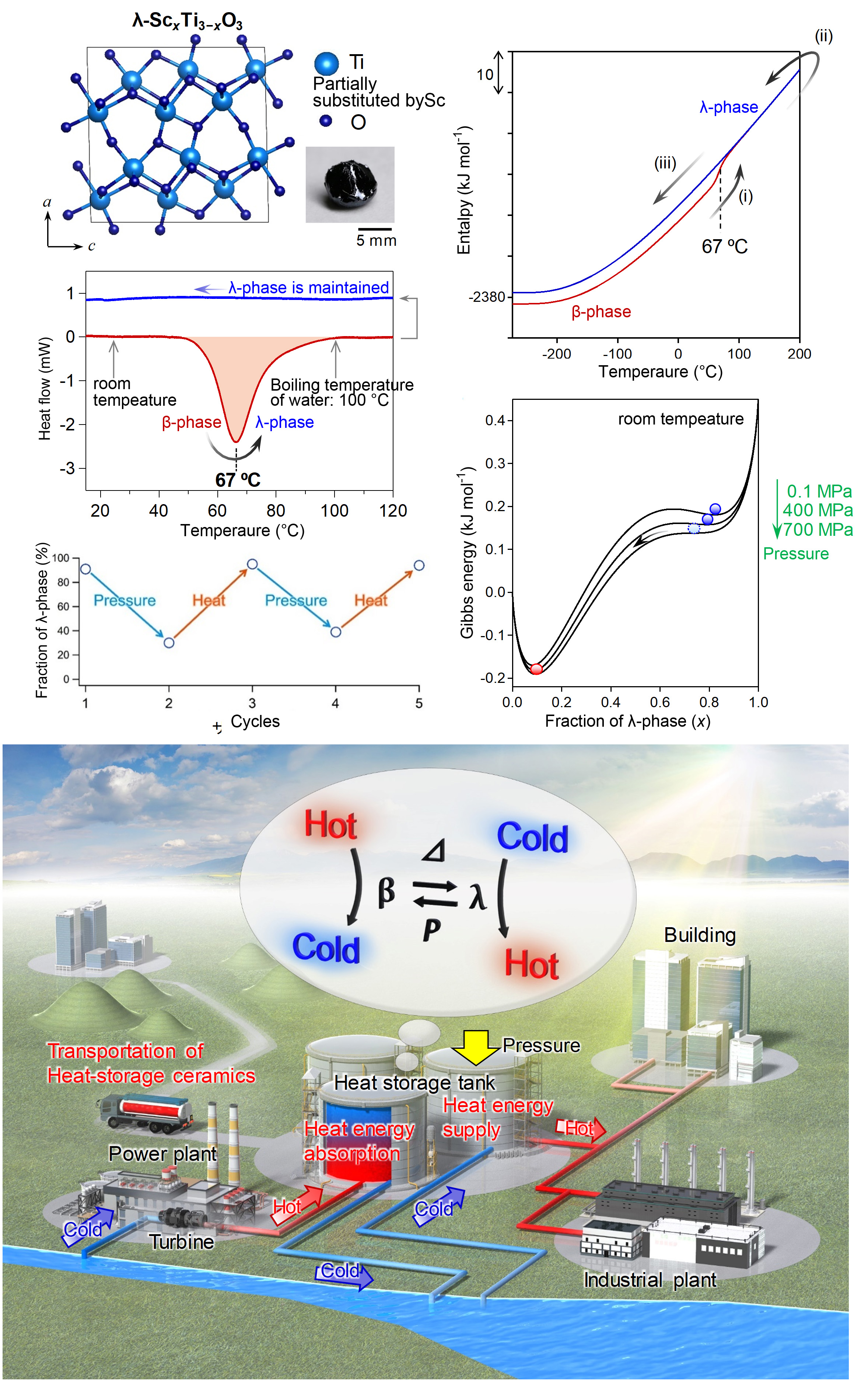
2. A new magnetic recording method using millimeter/terahertz waves
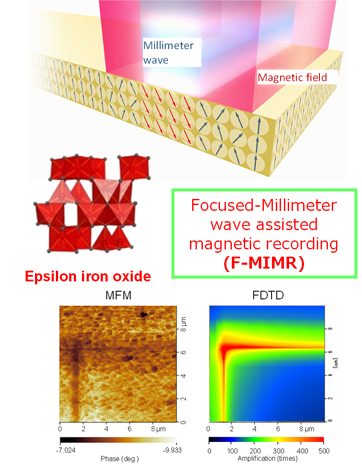
We developed a new magnetic recording method, “millimeter wave magnetic recording”, using millimeter and terahertz waves, in which focused millimeter wave is used to assist magnetization reversal. To test this methodology, magnetic films were prepared using gallium-titanium-cobalt-substituted epsilon-iron oxide (GTC-type ε-iron oxide), which is drawing attention as a magnetic filler for future magnetic recording tapes and also as a millimeter-wave absorber for Beyond 5G networks, and constructed a focused millimeter wave generator using terahertz (THz) light. Furthremore, a millimeter-wave focusing ring was designed using electromagnetic field analysis simulation and fabricated on the surface of the magnetic film to focus the millimeter wave corresponding to the resonance frequency of GTC-type ε-iron oxide. The sample was irradiated by a focused millimeter wave under an external magnetic field of 3.4 kOe, slightly weaker than the coercive field value of 4.9 kOe applied toward the opposite direction against the magnetization direction of the film. After irradiation, the magnetic force microscopy (MFM) image showed a dark shadow near the focusing ring, which agrees well with the magnetic field distribution map simulated by electromagnetic field analysis, indicating that the magnetization was flipped by the assistance of the focused-millimeter wave. F-MIMR is an innovative magnetic recording method for the Beyond 5G Era, combining light/electromagnetic waves of Beyond 5G networks and magnetic recording. Thus, F-MIMR could contribute to raising the magnetic recording density.
(S. Ohkoshi, et al., Adv. Mater., (2020).)
*This topic appeared on Nikkei Business Daily, the Chemical Daily newspaper, and the Science News.
3. Photoswitchable superionic conducting polar crystal
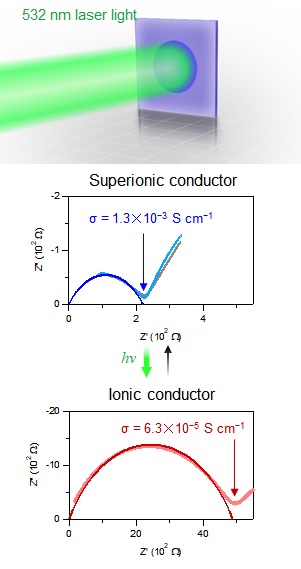
We developed a superionic conducting polar crystal exhibithing photo-switching effect. This three-dimensional anionic network is based on -Fe-N≡C-Mo- units, with Cs cations hosted in every other pore. In the resulting Cs1.1Fe0.95[Mo(CN)5(NO)]・4H2O material, the negative and positive charges of the framework and Cs+ ions, respectively, are non-symmetrically shifted in the c-axis direction of the unit cell, and spontaneous electric polarization is generated. When this 3D network is irradiated with 1040 nm light, spontaneous electric polarization is perturbed by the electric-field component of the fundamental laser light, generating SHG. Additionally, this material is a superionic conductor with an ionic conductivity value of 4×10-3 S cm-1 at 318 K which originates from proton conductivity in the 1D channels along the c axis composed of the NO groups and H2O molecules. Furthermore, the ionic conductivity significantly decreases under 532 nm light irradiation (from 1×10-3 S cm-1 to 6×10-5 S cm-1 at room temperature) and, when irradiation stops, returns to its original value within ~1 h. We hope that the present functionalities may be useful for allowing the photoswitching of conductivity in capacitors, separators and fuel batteries.
(S. Ohkoshi, et al., Nature Chemistry, (2020).)
*This topic appeared on Nikkei newspaper, the Chemical Daily newspaper, the Science News, EE Times Japan, etc.
4. Low pressure responsive heat storage ceramics
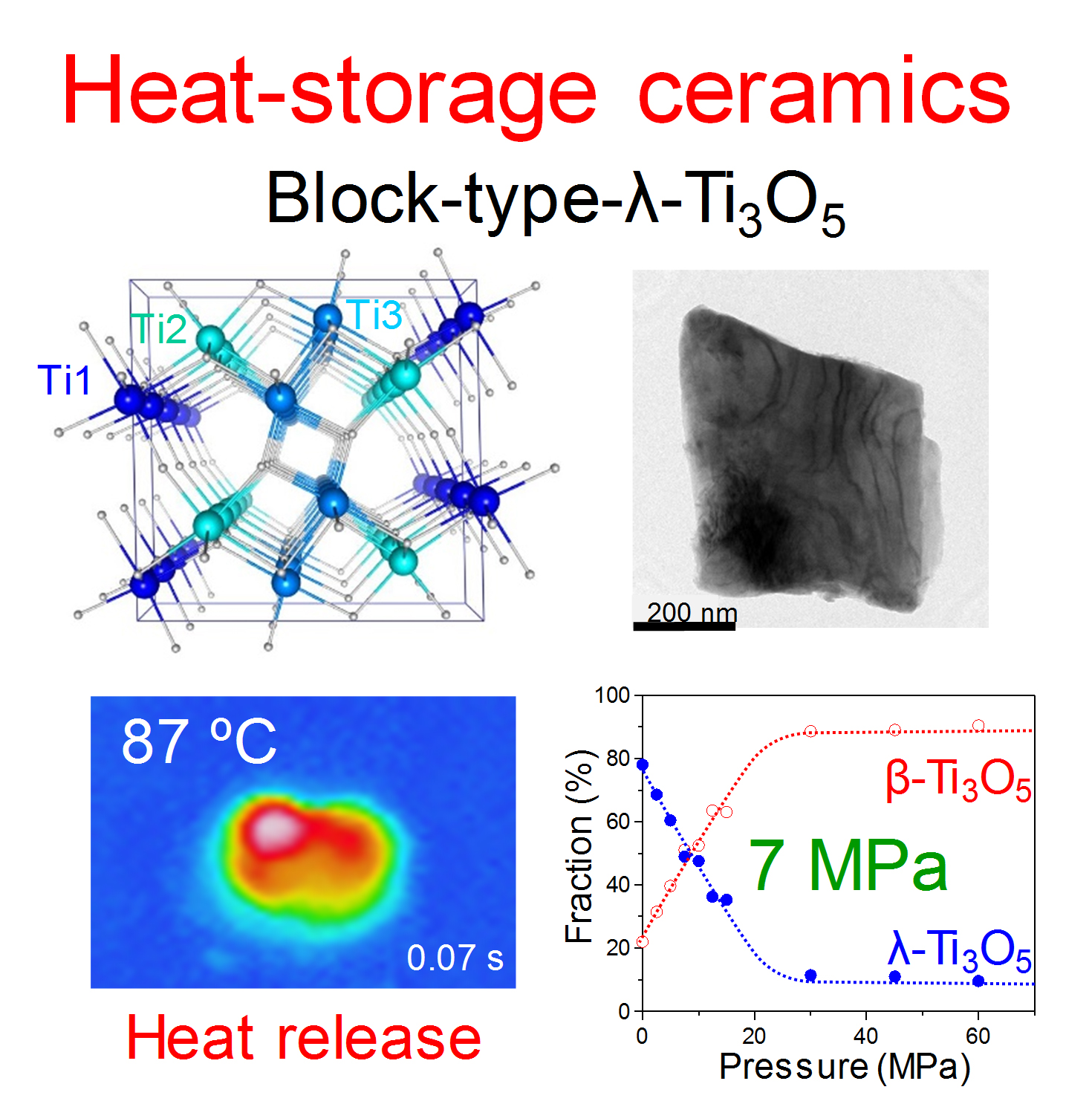
We developed heat-storage ceramic based on block-type λ-Ti3O5, which preserves a large latent heat energy of 237 kJ L-1 for a long period and shows a low pressure-induced heat energy release with a half transition pressure of 7 MPa that is smaller than the pressure of a compressed gas cylinder ranging from 12 to 30MPa. The observed properties originate from the bistability (λ- and β-phases) of the material and the existence of an energy barrier between the two phases. Due to the energy barrier, block-type λ-Ti3O5 exhibits one of the largest thermal hysteresis loops among condensed matter with a ΔT value of 265K. From the viewpoint of automobile applications, transition pressures below 10MPa are preferable. Therefore, the present heat-storage ceramic should be useful in automobile components near engines and mufflers, since the heat-storage ceramic can warm the cooled internal system when restarting the automobile. Additionally, an example of other possible applications is solar power plants. Since the present material has both properties of long-term latent heat storage and sensible heat storage, it is expected to be useful for the heat storage system at solar power plants.
(S. Ohkoshi, et al., Sci. Rep., (2019).)
*This topic appeared on Nikkei Business Daily, Nikkan Kogyo Newspaper, the Chemical Daily newspaper, the Science News, and MSR Bulletin News.
5. Magnetization reversal by light irradiation and ultrafast magnetization response by terahertz light in magnetic tape
We succeeded in observing nanosecond visible laser light-induced magnetization reversal and ultrafast magneto-optical effects induced by terahertz (THz) pulsed laser irradiation in magnetic films consisting of epsilon iron oxide and metal-substituted epsilon iron oxide fabricated using resins used for magnetic recording tape media. Irradiation of a nanosecond visible light laser onto a magnetic film based on ε-Ga0.27Ti0.05Co0.07Fe1.61O3 reversed the sign of the Faraday effect indicating a light-assisted magnetization reversal. Furthermore, an irradiation wiht pulsed THz light to a magnetic film based on ε-Fe2O3 caused an instant change of Faraday rotation with an extremely short time of 400 fs. The spin dynamics of the observed ultrafast magneto-optical effects has been demonstrated theoretically. These ε-iron oxide magnetic nanomaterials are expected to contribute to high-density magnetic memory media or high-speed operation circuit magnetic devices.
(S. Ohkoshi, et al., J. Am. Chem. Soc., (2019).)
*This topic appeared on Nikkei Business Daily and the Science News.
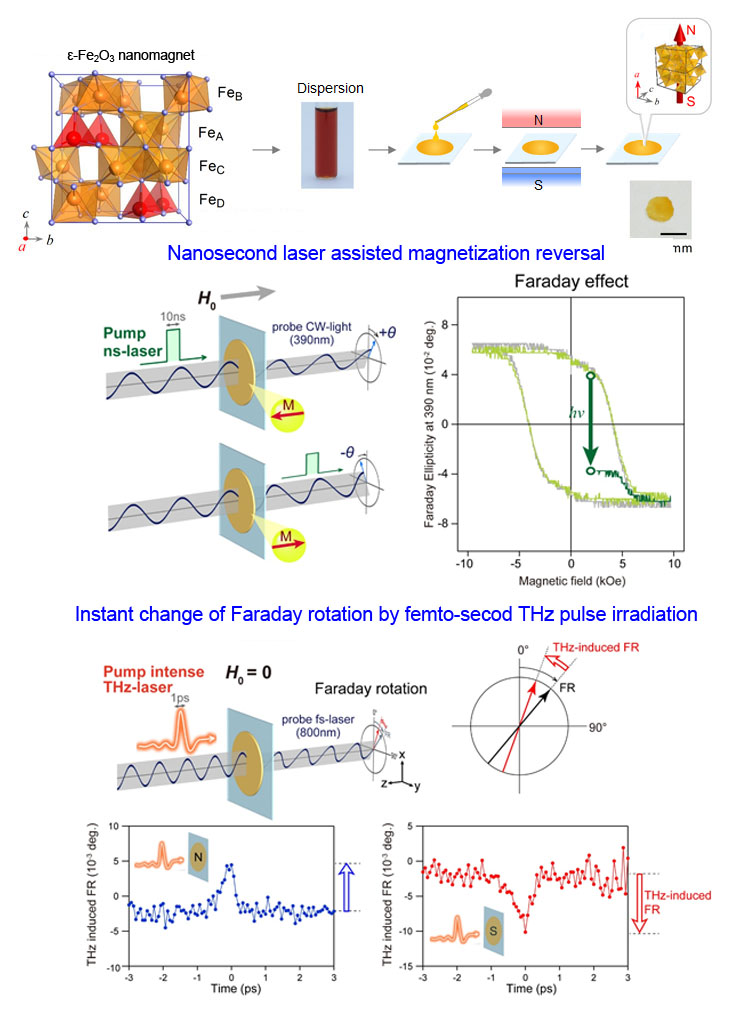
6. Theoretical prediction of phase transitions in solid materials by computer calculation
We show a logical strategy for designing a phase transition accompanying a thermal hysteresis loop using computer calculation. As an example, we predicted the charge-transfer phase transition on rubidium manganese hexacyanoferrate. First, the phase transition temperature was predicted by the first-principles phonon mode calculations of two phases and the width of thermal hysteresis was predicted by statistical thermodynamic calculations considering cooperative interaction. The predicted phase transition temperature and the thermal hysteresis loop agree well with the experimental results. This approach will contribute to the rapid development of yet undiscovered phase transition materials. Moreover, if the flowchart for a logical strategy to predict the phase transition shown in this study is eventually implemented to artifcial intelligence (AI), numerous phase transition materials could be discovered inside a computer.
(H. Tokoro, S. Ohkoshi, et al., Sci. Rep., (2018).)
*This topic appeared on Nikkei Business Daily, the Chemical Daily newspaper, and the Science News.
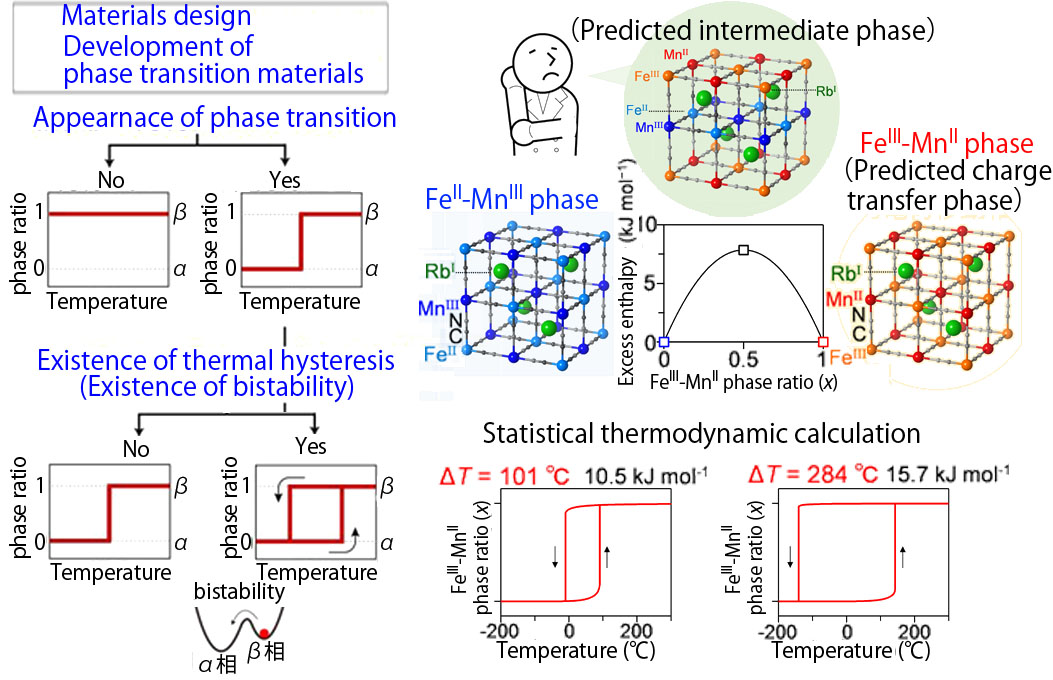
7. Discovery of a "heat-storage ceramic"
Researchers at the University of Tokyo have discovered a new type of material which stores heat energy for a prolonged period, which they have termed a “heat storage ceramic.” This new material can be used as heat storage material for solar heat energy generation systems or efficient use of industrial heat waste, enabling recycling of heat energy, since the material releases the stored heat energy on demand by application of weak pressure.
Materials capable of storing heat include those such as bricks or concrete that slowly release the stored heat, and others such as water or ethylene glycol that take in heat when they transform from a solid to a liquid. However, none of these materials can store heat energy over a long period as they naturally release it slowly over time. A material that could store heat energy for a long time and release it at the exact timing desired would be a boon for the field of renewable energy.
The heat storage ceramic discovered by the research group of Professor Ohkoshi at the University of Tokyo Graduate School of Science preserves heat energy for a prolonged period. This material, called stripe-type-lambda-trititanium-pentoxide, is composed of only titanium atoms and oxygen atoms, and can absorb and release a large amount of heat energy (230 kJ L-1). This heat energy stored is large at approximately 70% of the latent heat energy of water at its melting point. Additionally, applying a weak pressure of 60 MPa to stripe-type-lambda-trititanium-pentoxide induces a phase transition to beta-trititanium-pentoxide, releasing the stored heat energy. Besides direct application of heat, heat energy can be stored by passing an electric current through the material or irradiating it with light, enabling the repeated absorption and release of heat energy by a variety of methods.
Stripe-type-lambda-trititanium-pentoxide is a simple titanium oxide composed of abundant elements and is environmentally friendly. The present heat-storage ceramic is expected to be a new candidate for use in solar heat power generation systems, which are actively promoted nowadays by European countries, and also for efficient use of industrial heat waste. This material also has possibilities for use for advanced electronic devices such as pressure-sensitive sheets, reusable heating pads, pressure-sensitive conductivity sensors, electric current driven type resistance random access memory (ReRAM), and optical memory.
(H. Tokoro, S. Ohkoshi, et al., Nature Communications, (2015).)
*This topic appeared on Nature Japan "Focused Articles", Yomiuri newspaper, Nikkei newspaper, Nikkei Business Daily newspaper, Nikkan Kogyo newspaper, the Chemical Daily newspaper, Yahoo! news, and other many journals and newspapers.
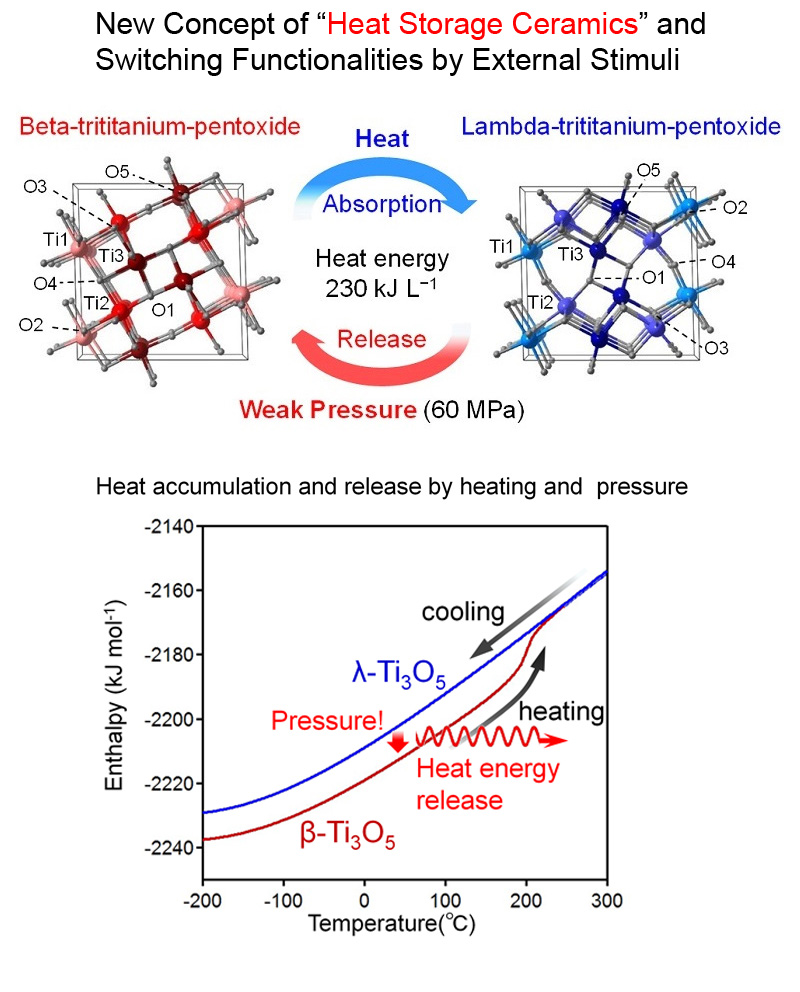
8. Cesium ion detection by THz light
If a heavy atom is encapsulated in a cage of a porous material, the atom should vibrate slowly and resonate with a low-frequency terahertz light. From this perspective, a cyanide-bridged metal framework is a suitable system because it contains many cages that can adsorb Cs ions. In this study, we investigated the vibration mode of a Cs ion in a cage of a manganese-iron cyanide-bridged metal framework. First-principles phonon mode calculations and terahertz time-domain spectroscopy (THz-TDS) measurements indicate that the vibration mode of a Cs ion in a cyanide-bridged manganese-iron framework is at 1.5 THz, which is significantly apart from other lattice vibrations. Furthermore, the THz-TDS measurement of Cs non-containing cyanide-bridged manganese-iron framework after immersing into cesium-containing aqueous solution indicated that the amount of adsorbed Cs ion can be monitored by THz-TDS spectroscopy. The saturation adsorption amount is 511±55 mg/g, which is higher than Prussian blue. Diffusion of radioactive Cs to the environment has been a serious issue, and its decontamination is an important mission after the accidents at nuclear power plants, e.g., the 2011 Fukushima accident. From this viewpoint, the combined system of THz-TDS with a cyanide-bridged metal framework demonstrated in this work will provide an effective detection method for non-contact sensing of Cs ions.
(S. Ohkoshi, et al., Scientific Reports, (2017).)
*This topic appeared on Nikkei online, Nikkei Business Daily newspaper, Nikkan Kogyo newspaper, the Chemical Daily newspaper, the Science News.
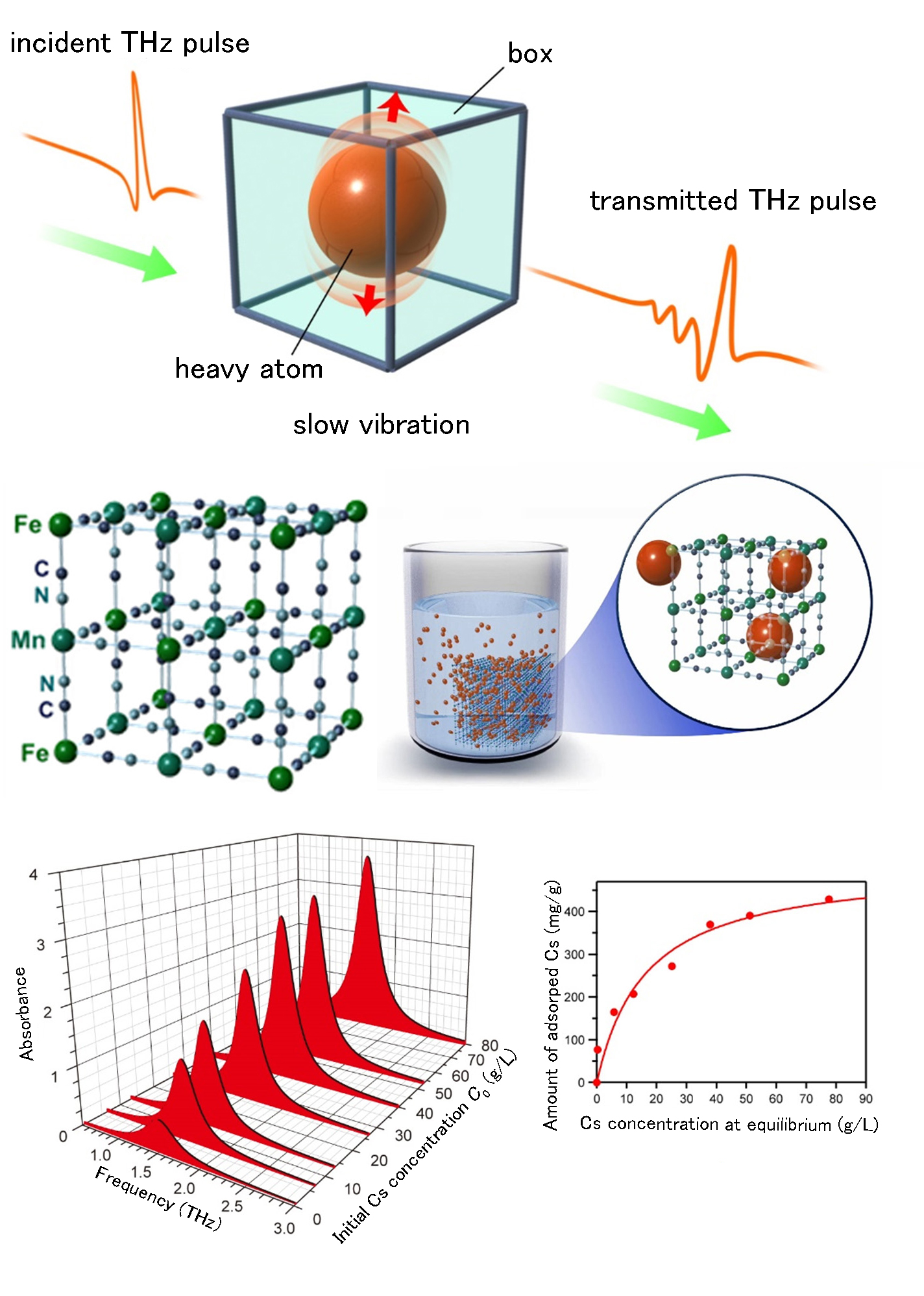
9. Largest coercive field ferrite magnet in a crystallographically oriented film based on metal-substituted ε-iron oxide
In this study, we prepared a magnetic thin film of crystallographically oriented rhodium-substituted ε-iron oxide using an applied external magnetic field. An almost perfectly oriented magnetic thin film with a Lotgering factor of 0.96 was obtained. The obtained material showed a remarkably large coercive field (Hc) value of 35 kOe at room temperature, which is the largest value among magnetic ferrites to date. Furthermore, when the temperature dependence of the magnetic properties was measured, an even larger Hc value of 45 kOe was recorded at 200 K. Such large Hc values are much larger than those of conventional hard magnetic ferrites.
(S. Ohkoshi, et al., J. Am. Chem. Soc., (2017).)
*This topic appeared on Nikkei online, Nikkei Business Daily newspaper, Nikkan Kogyo newspaper, the Science News.
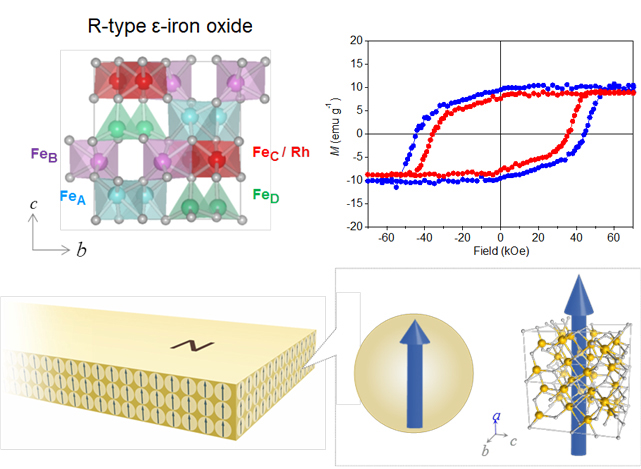
10. Microscopy probe to observe strong magnets using rustproof ferrite bar magnet which withstands strong magnetic field and electric current
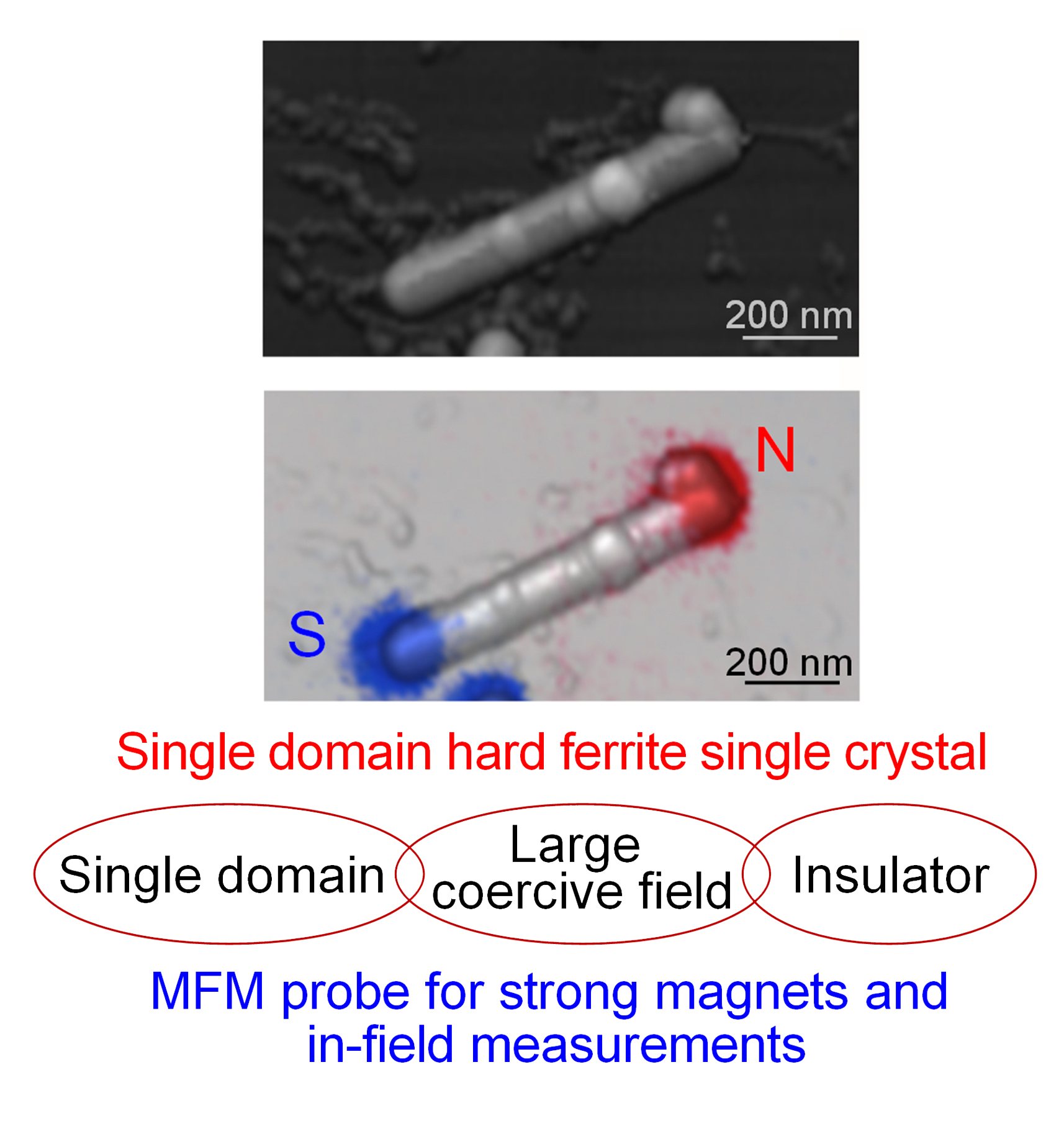
We have developed a magnetic force microscopy probe, enabling observation of the surface of strong magnets and in-field measurements (measurements under a magnetic field), both difficult with conventional techniques. This was made possible by the development of a submicrometer size, extremely powerful ideal ferrite bar magnet. Ferrite bar magnets are composed of abundant and low cost materials and have been used in toys, stationery, and crafts. Typical black ferrite bar magnets are produced by hot pressing magnetic powder, and therefore, the bar magnet cannot be a single magnetic domain material (magnetic material with one pair of N-pole and S-pole). In this reserach, we succeeded in developing an ideal single crystal hard ferrite bar magnet with a single magnetic domain. Instead of compressing magnetic powder, the magnets were produced by using a unique chemical synthesis method, the combination of the reverse-micelle and sol-gel methods. This bar magnet is a submicrometer size single crystal ferrite bar magnet composed of epsilon ferric oxide (ε-Fe2O3), whose magnetic poles do not easily flip with even under strong magnetic field, and it is resistant to strong magnetic field, electric current, and also does not rust. Taking advantage of these properties, the research group developed a probe for magnetic force microscopy (MFM) and a paint and film using the material as a high frequency millimeter wave absorber. This ferrite bar magnet is expected to find applications in the emerging Internet of Things as a high frequency millimeter wave absorbing material for safe driving support systems and the ferrite magnet we have developed in this research will be displayed in the special exhibition at the Science Museum, London from 15th July 2016.
(S. Ohkoshi, et al., Scientific Reports, (2016).)
*This topic appeared on Nikkei Business Daily newspaper, the Science News, Yahoo! News, and EE Times.
11. Development of a magnetic recording tape using epsilon iron oxide
We developed a new series of nanomagnet based on epsilon iron oxide (ε-Fe2O3), ε-Ga0.31Ti0.05Co0.05Fe1.59O3, where Fe ions of ε-Fe2O3 are substituted by three metal ions, i.e., gallium ion, titanium ion, and cobalt ion. By controlling the metal substitution ratios, the coercive field of this metal-substituted epsilon iron oxide was tuned to a suitable value for magnetic recording of 3 kOe. The magnetization value also improved from ε-Fe2O3 by 44%. The present epsilon iron oxide nanomagnet was then synthesized in a medium-size production scale (5 kg), and a trial production of a magnetic tape was developed. The regenerative signal of the manufactured magnetic tape was very sharp, and the media noise was found to be extremely low. Therefore, The present epsilon iron oxide nanomagnet is expected as next-generation magnetic recording material for magnetic tapes in large capacity archiving.
(S. Ohkoshi, et al., Angew. Chem. Int. Ed., (2016). (Hot Paper))
*This topic appeared on the Chemical Daily newspaper, Nikkan Kogyo newspaper, and the science news.
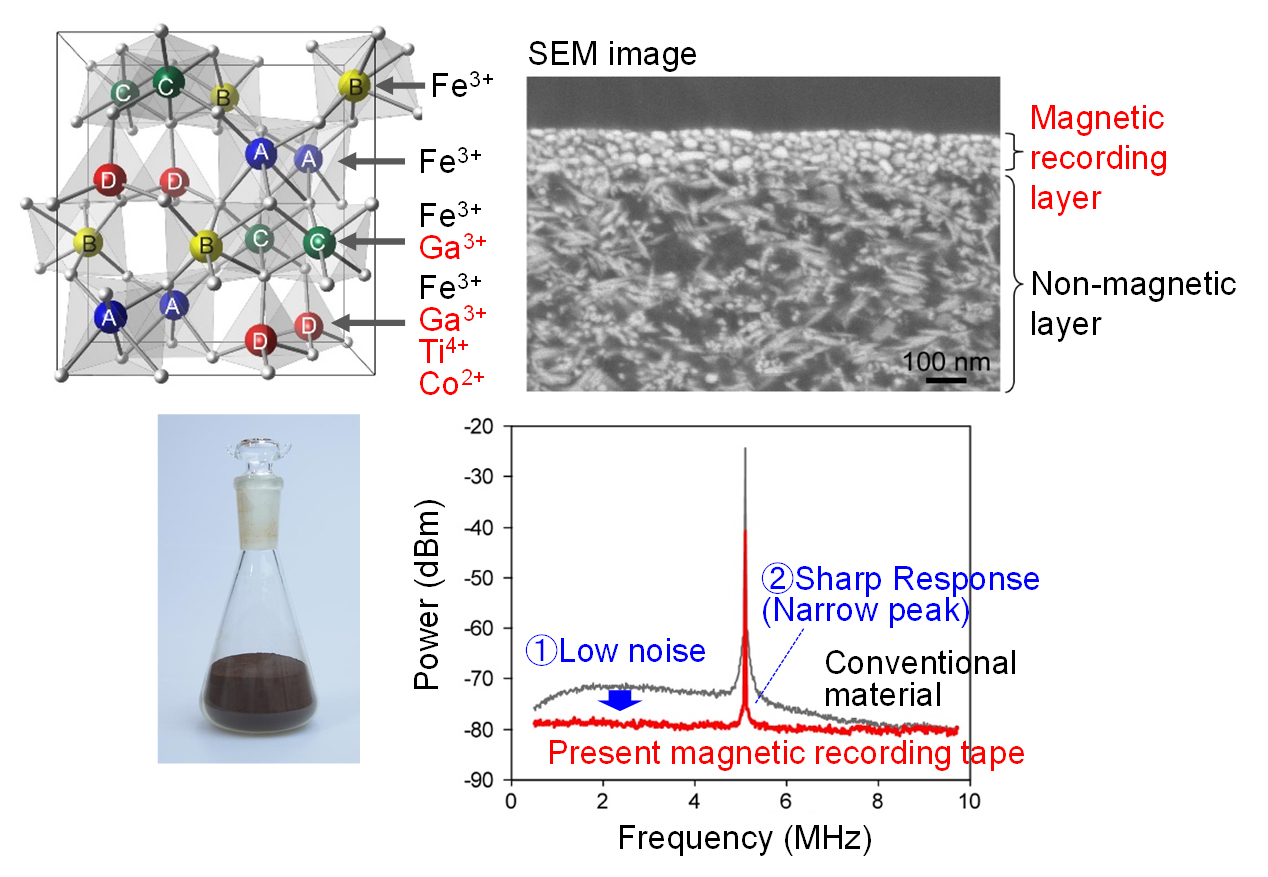
12. The world's smallest hard ferrite magnet
Research group at the University of Tokyo has successfully developed the world's smallest nanomagnet, a single-digit nanosize hard ferrite magnet composed of iron oxide. Being composed of iron and oxygen, the magnet is eco-friendly, low cost, and suitable for mass production. The magnet should find applications in high-density magnetic recording for the next generation of archive media.
Ferrite magnets made of iron oxide are widely used in permanent magnets, magnetic recording media, electromagnetic wave absorbing materials, and magnetic fluids. Ferrite magnets have found applications as magnetic recording media, but there is ever greater need to increase the storage density of such materials. One important challenge for increasing density is the development of nanometer-scale magnetic particles with a large coercivity (that is, resistance to change in magnetic state). Ferrite magnets have the chemical stability required at the nanometer scale, but since known materials cannot maintain magnetism as particle size is reduced, there were no hard ferrite magnets with a particle size of less than ten nanometers.
The research group of Professor Shin-ichi Ohkoshi in the Graduate School of Science, the University of Tokyo, has developed a new method to systematically synthesize epsilon-type iron oxide (ε-Fe2O3) particles of different sizes in the range of 5 to 40 nm, and revealed that ε-Fe2O3 larger than 7.5 nm exhibits magnetic properties (ferromagnetic phase transition). For use in magnetic recording media such as magnetic tape and hard discs, a material should have a coercive field larger than 3 kOe. The present material exhibits a coercive field of 5 kOe at 8 nm particle size, demonstrating its potential as a material for ultra-high density magnetic recording. In addition, epsilon-type iron oxide has been shown theoretically and experimentally to exhibit not only ferromagnetic properties but also spontaneous electric polarization, making it also the smallest multiferroic ferrite particle yet.
Iron oxide, composed of only iron and oxygen, is a suitable material for mass production since this material is eco-friendly and low cost. The developed single-nanosize hard ferrite magnet is expected to be applied in the next generation use of high-density magnetic recording for archive media.
(S. Ohkoshi, et al., Scientific Reports, (2015).)
*This topic appeared on Nikkan Kogyo newspaper, the Chemical Daily newspaper, and Kinzoku jihyo.
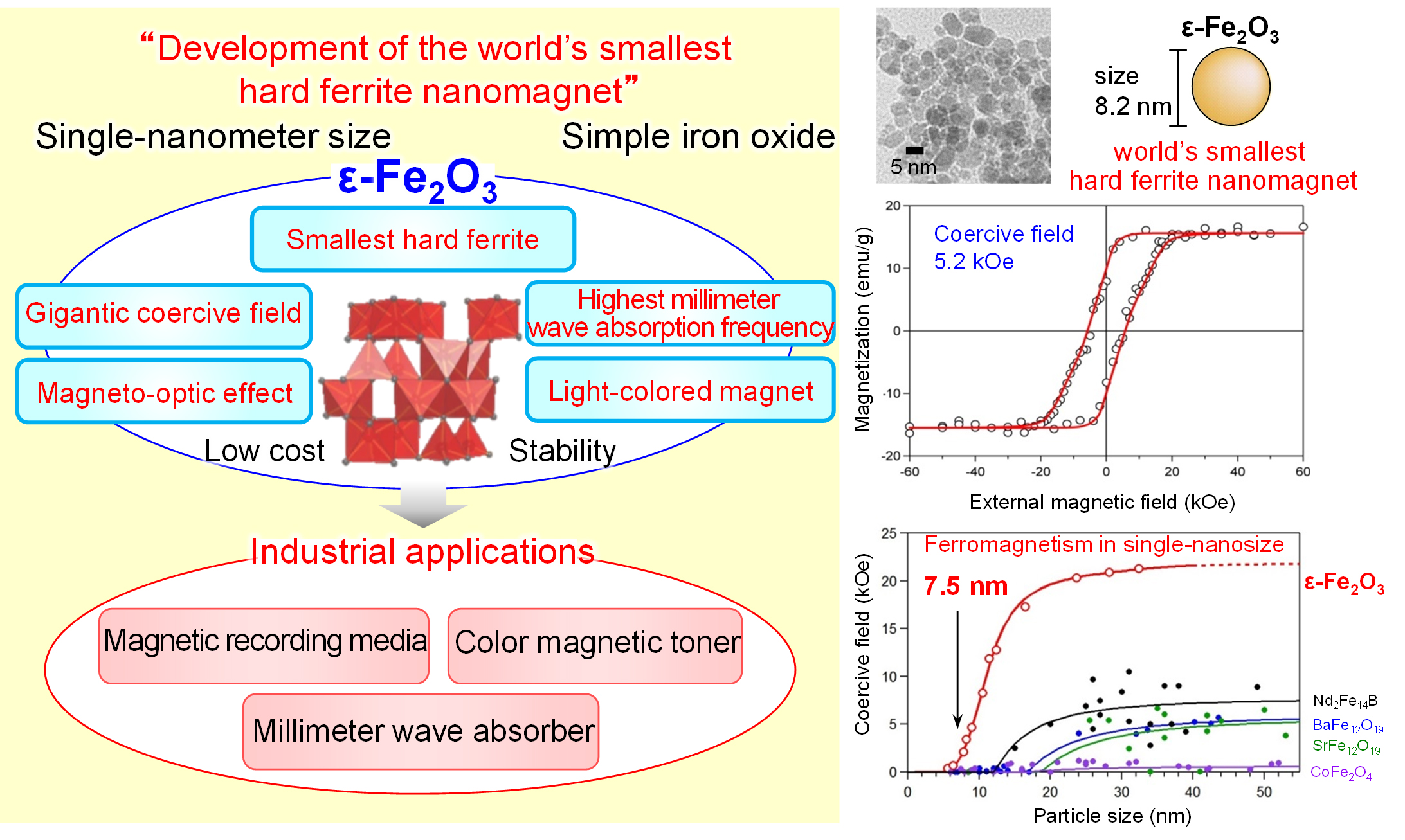
13. 90-degree optical switching of output light in the first chiral photomagnet
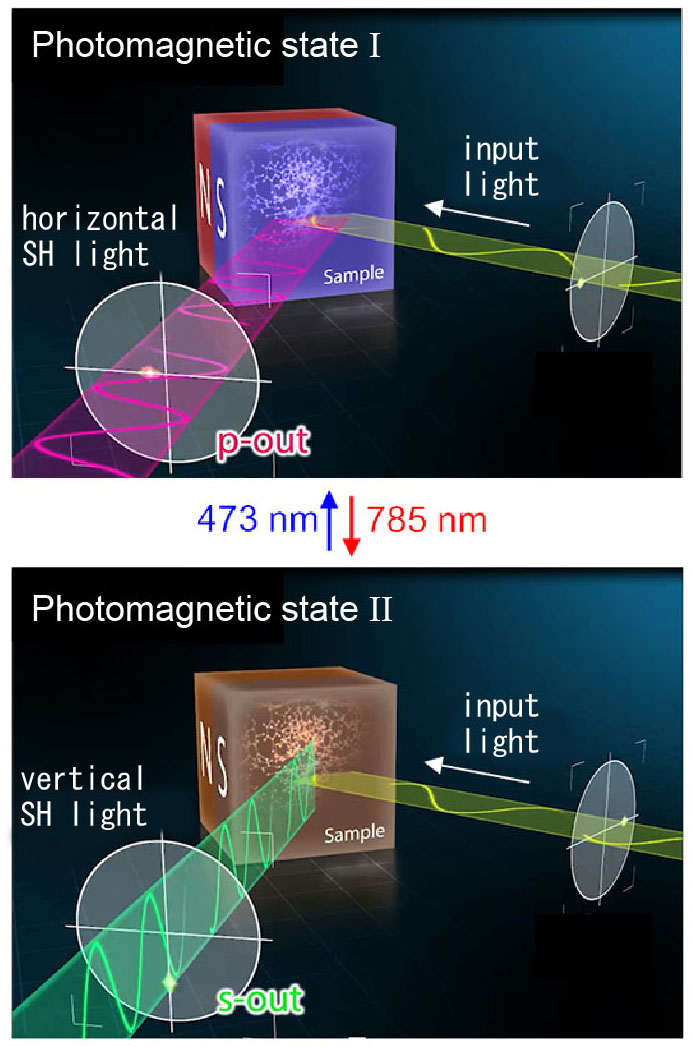
Prof. Shin-ichi Ohkoshi's research group has discovered a novel phenomenon, where the polarization plane of the output light from the material is reversibly switched between horizontal and vertical, by introducing chirality into a photo-responsive magnet. We developed a new chiral structured magnet, where iron (Fe) ions and niobium (Nb) ions are three dimensionally bridged by cyano groups (CN). By alternatively irradiating with blue light (wavelength: 473 nanometers) and red light (wavelength: 785 nanometers), the magnetization of the material can be reversibly switched (hereafter, we call this new magnet a chiral photomagnet). Using this chiral photomagnet, we investigated second harmonic generation (a phenomenon where an input light with a particular wavelength is converted to an output light with half the wavelength), one of the nonlinear optical effects. As a result, at a nonmagnetic state before light irradiation, input light with a horizontal polarization plane was converted to an output light with a vertical polarization plane. However, when the sample was transformed into a magnetic state (photomagnetic state I) by irradiating with blue light, an output light with a horizontal polarization plane was observed. Furthermore, when irradiated with red light to generate a magnetic state with weak magnetization (photomagnetic state II), the polarization plane of the output light was returned to vertical. In this way, we succeeded in 90-degree switching of the polarization plane of the output second harmonic light by changing the state of the magnet with blue and red light. There have not been any other reports of chiral photomagnets, and this is the first successful example in the world. With the development of such a novel material, chirality and magnetic properties were coupled to exhibit 90-degree switching of the polarization plane of the output light. This switching ph
enomenon, which is totally different from the conventional Faraday effect, was achieved by combining the cutting-edge technologies of optical science and material science. In this chiral photomagnet, the switching angle can be controlled from 0 to 90 degrees by changing the photo-induced magnetization value. By using the intermediate angles, n-ary systems (n = 2, 4, 8, 16, ..., 256, ...) will be possible other than the "0" and "1" binary system, which should encourage studies on advanced magneto-optical phenomena and applications for multinary notation high-density magneto-optical memory and optoelectronic devices.
(S. Ohkoshi, et al., Nature Photonics, (2014).)
*This topic was highlighted at Nature Photonics Cover Picture
and appeared on Nature Photonics "interview", Nikkei newspaper, Nikkei Business Daily newspaper, the Chemical Daily newspaper, science news, Yahoo! news, and other many journals and newspapers.
14. Hard magnetic ferrite with gigantic coercivity and high frequency millimeter wave rotation
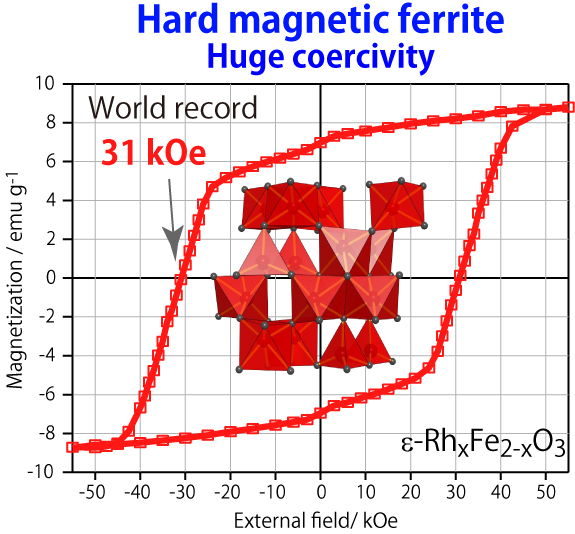
We have synthesized a novel ferrite magnet, rhodium-substituted ε-Fe2O3 (ε-RhxFe2?xO3) nanomagnets, by a nanoscale chemical synthesis. The present material recorded a coercive field of 31 kOe, which is the largest value among metal-oxide-based magnets and is comparable to those of rare-earth magnets. In addition, ε-Rh0.14Fe1.86O3 exhibits a rotation of the polarization plane of the propagated millimeter wave at 220 gigahertz, which is one of the promising carrier frequencies for wireless communications due to its high transmittance of air (the window of air).The present magnetic ferrite has potential in future high-density magnetic recording media due to its gigantic coercivity. The present material should be useful for high frequency millimeter wave absorbers and rotators (isolators or circulators) as it should restrict electromagnetic interference problems.
(A. Namai, S. Ohkoshi, et al., Nature Communications, 3, 1035 (2012).)
*This topic appeared on Nature Materials "Research highlight", Nature Japan "Focused article", Yahoo! news, and other many journals and newspapers.
15. Synthesis of a metal oxide with a room-temperature photoreversible phase transition
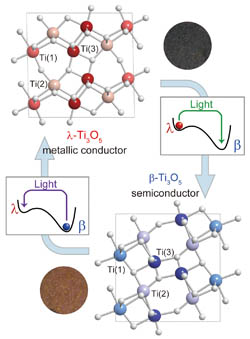
We have discovered a new type of metal oxide which shows reversible transition between metal and semiconductor by photo irradiation at room temperature. This new type of metal oxide (lambda type trititanium pentoxide: λ-Ti3O5) (Hereafter, it is called lambda type titanium oxide) was synthesized by the chemical technique using surfactant. This material shows photoinduced phase transition (photoinduced metal-insulator transition) from black colored lamda phase (metallic conductor) to brown colored beta phase (β-Ti3O5) (semiconductor). Moreover, the reverse phase transition was also observed by the photoirradiation. This is the first example of a metal oxide which shows photorewritable phenomenon at room temperature. Lamda titanium oxide is a simple material that consists only of titanium atom and oxygen atom, and hence it is very economical and environmentally benign material. Lamda titanium oxide is promising as a next generation optical storage material because it is obtained in a particle size of 10-20 nm. Furthermore, the lamda titanium oxide can be obtained by a simply calcination of the commercial TiO2 photocatalyst under hydrogen, which is an industrial advantage from the viewpoint of cost and mass production.
(S. Ohkoshi et al., Nature Chemistry, (2010).)
*This topic appeared on Nature Chemistry "News & Views", Nature Japan, Agence France-Presse (AFP), NHK news, and other many journals and newspapers.
16. Light-induced spin-crossover magnet
We discovered a new type of photomagnet which exhibits transition from paramagnet (nonmagnetically ordered phase) to ferromagnet (magnetically ordered phase) by the blue light irradiation. The photomagnetic phase shows a ferromagnetic phase transition temperature of 20 K, which is caused by light-induced spin-crossover phenomenon, and returns to the original paramagnetic state by thermal annealing. This material is composed of iron(II) ion, niobium ion, organic ligand (4-pyridinealdoxime), and cyano group. This light-induced spin-crossover magnet contains a lot of organic molecules and this may be the first step toward flexible optical-magnetic material.
(S. Ohkoshi et al., Nature Chemistry, (2011).)
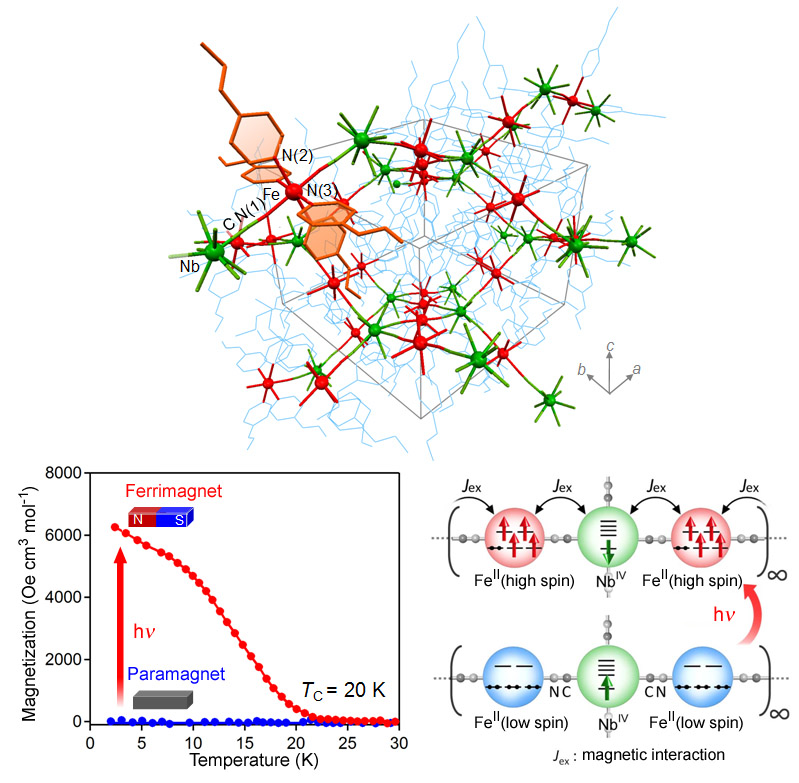
17. Synthesis of metal complexes with novel magnetic functionalities
(1) Humidity-induced magnetization and magnetic pole inversion in a cyano-bridged metal assembly
We have observed humidity-induced reversible variations in the magnetic properties of cyano-bridged
metal assemblies, (CoII0.41MnII0.59)[CrIII(CN)6]2/3・zH2O.
The observed magnetic humidity response is due to adsorption
and desorption of a ligand water molecule on the cobalt ion,
which changes CoII between a 6- and 4-fold coordination
geometry and switches the magnetic interaction between ferromagnetic
coupling and antiferromagnetic coupling.
(S. Ohkoshi et al., Nature Materials, 3,
857 (2004).)
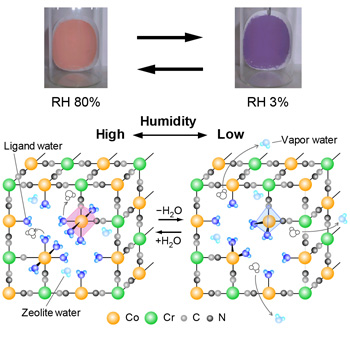
(2) Spin-ionics
We observed high proton conductivities on Co[Cr(CN)6]2/3・zH2O and V[Cr(CN)6]2/3・zH2O, respectively, and an interference effect between magnetic ordering and ionic conduction below magnetic phase transition temperature. The observation of such an interference effect may open a new field, so-called, "spin-ionics".
(S. Ohkoshi et al., J. Am. Chem. Soc., (2010).)
*Research Highlights of Nature Asia Materials
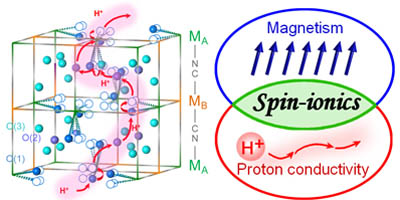
(3) Ferroelectric-ferromagnetic cyano-bridged metal assembly
We have observed the coexistence of ferroelectricity
and ferromagnetism in Rb0.82Mn[Fe(CN)6]0.94・H2O.
The ferroelectricity is due to the mixing of Fe vacancies and
FeII, FeIII, MnII, and Jahn-Teller-distorted
MnIII centers, and the ferromagnetism is mainly caused
by a parallel ordering of the magnetic spins on the MnIII centers.
(S. Ohkoshi et al., Angew. Chem. Int. Ed., (2007).)
*highlighted in the frontispiece

(4) Design and Preparation of a Novel Magnet Exhibiting Two Compensation Temperatures
We have prepared a novel type of magnet exhibiting two compensation
temperatures; i.e., the spontaneous magnetization changes its sign
twice with changing temperature. The key to obtaining this unusual
behavior is the simultaneous incorporation of one antiferromagnetic
and two different ferromagnetic interactions through the use of
four different spin sources, as predicted by a calculation based
on molecular field theory. As a prototype exemplifying this idea,
we have prepared a Prussian blue analog, (NiII0.22MnII0.60FeII0.18)[CrIII(CN)6]2/3・5.1H2O,
which exhibits magnetization reversals at 35 and 53 K.
(S. Ohkoshi et al., Phys. Rev. Lett., 82, 1285 (1999).)
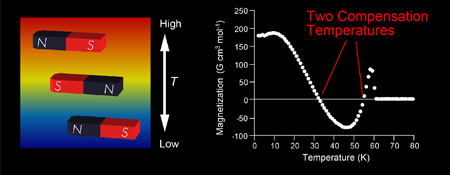
(5) Chemical-sensing magnet (Alcohol vapor)
A copper(II) octacyanotungsten(V)-based ferromagnet, CuII3[WV(CN)8]2(pyrimidine)2・8H2O,
was prepared. This magnetic material can reversibly adsorb and
desorb n-propanol vapor, and shows reversible variations in
the crystal structure and magnetic properties. These changes
are due to the coordination geometry switching of CuII between 6-coordinate and 5-coordinate.
(S. Ohkoshi et al., J. Am. Chem. Soc., 129,
3084 (2007).)

(6) Ferroelectricity in paramagnetic metal assembly
We have observed the ferroelectricity in a copper octacyanomolybdate-based paramagnet, Cu2[Mo(CN)8]・8H2O (CuII: S= 1/2, MoIV: S= 0). This compound has a freezing point for the fixation of hydrogen bonding at 150 K. Around this temperature, an enhancement in the ferroelectricity and an increase in the dielectric constant are observed. The ferroelectricity of this system is classified into amorphous ferroelectrics, i.e., the electric poling effect induces an electric polarization, maintained by the structural local-disorder of hydrogen bonding and the 3-dimensional CN network.
(K. Nakagawa et al., Inorg. Chem., 47,
10810 (2008).)
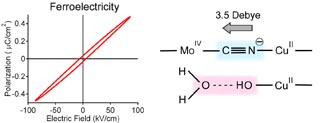
(7) Design and preparation of a bulk magnet exhibiting an inverted hysteresis loop
We have prepared a bulk magnet exhibiting an inverted magnetic hysteresis
loop, i.e., the magnetization becomes negative in the decreasing
part even when the applied field is still positive, while the magnetization
becomes positive in the increasing part when the applied field is
still negative. The key to obtaining this unusual magnet is to utilize
a competing effect between the spin-flip transition and the uniaxial
magnetic anisotropy. On the basis of the model calculations considering
this effect, we have succeeded in synthesizing a bulk magnet, (SmIII0.52GdIII0.48)[CrIII(CN)6]・4H2O
showing the inverted magnetic hysteresis loop.
(S. Ohkoshi et al., Phys. Rev. B, 64,
132404 (2001).)
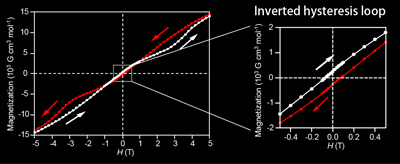
(8) Molecule-based magnet with a high Curie temperature (TC= 210 K)
We prepared a cyano-bridged V-Nb bimetal assembly, K0.59VII1.59VIII0.41[NbIV(CN)8]・(SO4)0.50・6.9H2O, exhibiting ferrimagnetism with a high Curie temperature (TC) of 210 K, which is the highest TC value among octacyano-bridged bimetal assemblies. Such a high TC value derives from the high coordination number of octacyanoniobate and the strong superexchange interaction between VII(S = 3/2) and NbIV(S = 1/2) via the CN groups.
(K. Imoto, S. Ohkoshi et al., Eur. J. Inorg. Chem., 2649-2652 (2012).)
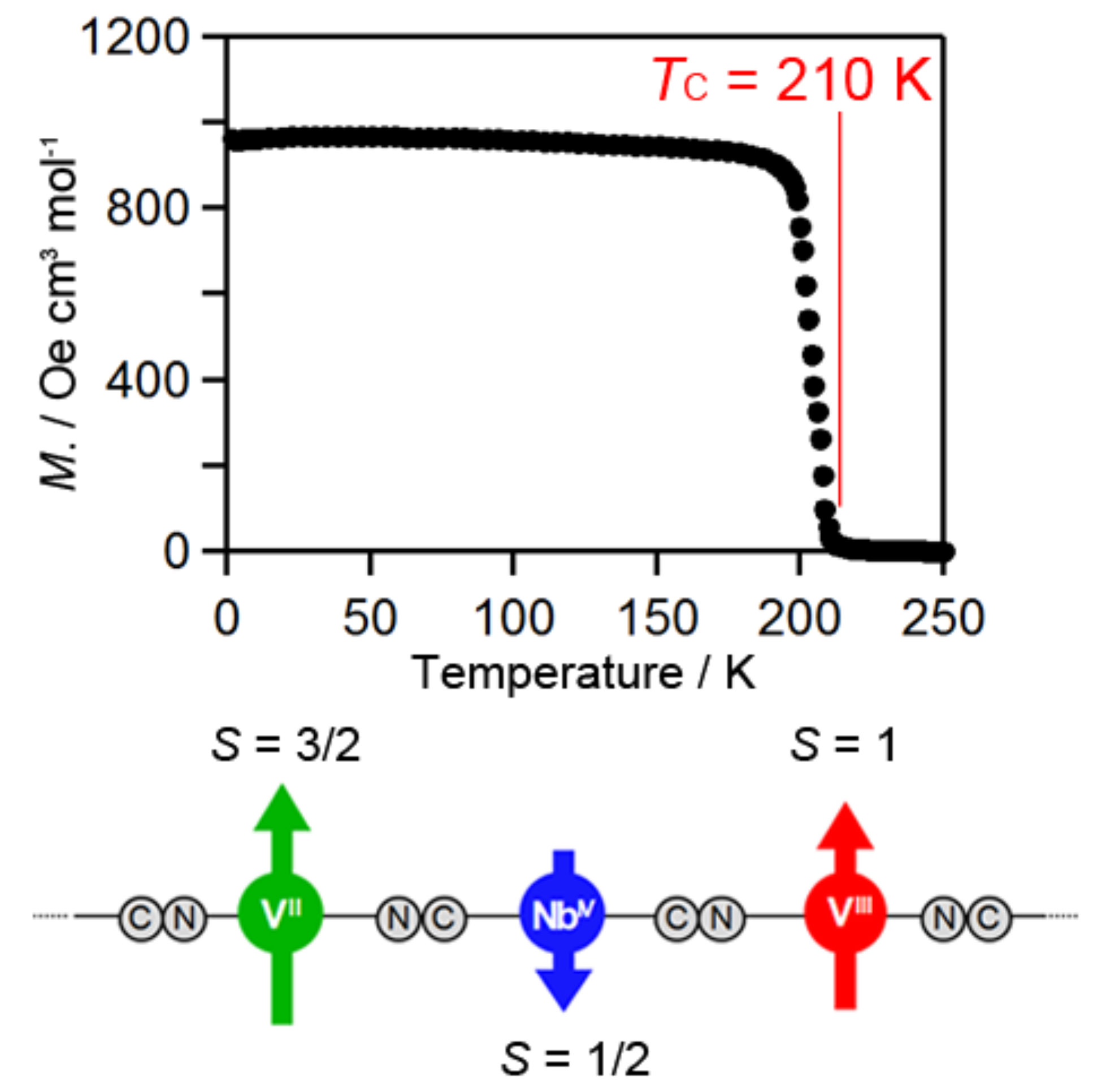
(9) A high-spin cluster, a two-dimensional metamagnet compound, and a pillared layer molecular-based material
We have synthesized molecular-based magnets built by octacyanometalates
[M(CN)8]n- (M = Mo, W) with
controlled its dimensionality. As a zero-dimensional magnet,
{Mn9[W(CN)8]・24C2H5OH}
cluster with the highest ground-state S = 39/2 was synthesized.
Two-dimensional cyanide-bridged copper(II) octacyanotungstates
were prepared and these compounds exhibited metamagnetic behavior
with Neel temperatures. We reported a three-dimensional manganese(II)
octacyanotungsten(V)-based magnet which contains a noncoordinated
aromatic molecule.
(S. Ohkoshi et al., Chem.Commun.2003, JACS 2000, JACS 2003, and JACS 2004)

(10) Coexitence of Fe(II) spin crossover and ferromagnetism
Thermal phase transition phenomenon was observed in CsFe[Cr(CN)6]・1.3H2O, due to a spin-crossover on the Fe(II) sites. This compound also showed a spontanepus magnetization with a magnetic ordering temperature of 9 K. This is a first compound which shows spin-crossover and ferromagnetism.
(S. Ohkoshi et al., J. Am. Chem. Soc., 127, 8590 (2005). )

(11) A ferrimagnet with a continuous spin-crossover phenomenon
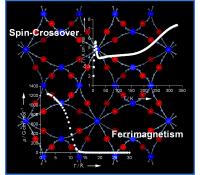
A spin-crossover from FeII(S=2)-NbIV(S=1/2)-FeII(S=2) to FeII(S=0)-NbIV(S=1/2)-FeII(S=2) occurs in Fe2[Nb(CN)8]・(3-pyCH2OH)8・4.6 H2O (3-py=3-pyridyl) with decreasing temperature. The low-temperature phase shows ferrimagnetism with a Curie temperature of 12 K owing to an antiferromagnetic interaction between the remaining FeII (S=2) and the NbIV (S=1/2) centers.
(M. Arai et al., Angew.Chem. Int. Ed., 47, 6885 (2008) )
(12) Photomagnetism
We have synthesized five types of photomagnetic materials, i.e. photo-induced magnetic pole-inversion material of (Fe0.40Mn0.60)1.5[Cr(CN)6], time-dependent photomagnetic material of RbMn[Fe(CN)6], visible light reversible photomagnetic material of Cu2[Mo(CN)8], and photomagnetic material of [{Co(3-CNpy)2}{W(CN)8}] and Fe[Cr(CN)6]. The examples are as follows;
(A) Photoinduced magnetic pole inversion
We designed the magnet exhibiting magnetic pole (N and S)
inversion by photostimuli. A ferro-ferrimagnet (FeII0.40MnII0.60)1.5CrIII(CN)6・7.5H2O
mixed by ferromagnetic (Fe-Cr system showing the change of magnetization
by optical stimuli) site and ferrimagnetic (Mn-Cr system showing
no optical response) site showed negative magnetization at the
temperature lower than compensation temperature (Tcomp = 19 K). In this mixed metal cyanide magnet we have succeeded
in demonstrating a novel magnetic behavior ‘‘photoinduced magnetic
pole inversion’’. Moreover, the magnetic pole inversion can
be induced repeatedly by alternate optical and thermal stimulations.
(S. Ohkoshi et al., Appl. Phys. Lett., 70,
1040 (1997); J. Am. Chem. Soc., 121, 10591
(1999).)
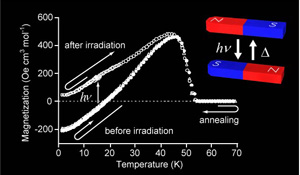
(B) Time dependent photo-induced magnetic phase
We studied on the photomagnetic effect on RbMn[Fe(CN)6].
By irradiation with only one-shot of laser pulse, magnetization
of the LT phase was disappeared at 3 K. In contrast, when the
LT phase was irradiated by the weak CW laser light at 3 K, the
spontaneous magnetization suddenly disappeared. This demagnetization
state was maintained for several minuets, and then, the magnetization
abruptly recovered to the initial state.
(S. Ohkoshi et al., J. Phys. Chem B, 106,
2423 (2002); H. Tokoro et al., Appl. Phys. Lett., 82, 1245 (2003).)
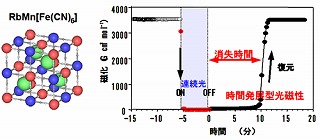
(C) Photo-induced reversible magnetization
We have syntesized a visible light-induced reversible photomagnetism
in CuII2[MoIV(CN)8]・8H2O.
By the irradiation with a 473 nm blue light, a spontaneous magnetization
with a magnetic ordering temperature (Tc)
of 30 was observed. Conversely, the magnetization and Tc values were reduced by the irradiation with light above 520
nm. This photomagnetism is due to the reversible photo-induced
electron transfer between paramagnetic CuII-NC-MoIV and its valence isomer CuI-NC-MoV exhibiting
ferromagnetism.
(S. Ohkoshi et al., Chem. Lett., 4,
312 (2001); J. Am. Chem. Soc., 128, 270
(2006); T. Hozumi et al., J. Am. Chem. Soc., 127,
3864 (2005).)
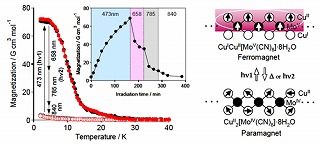
(D) A high-performance photo-reversible magnet
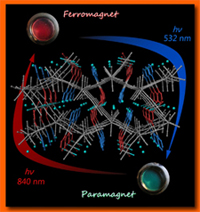
A high-performance photo-reversible magnet has been developed. The prepared material, Co3[W(CN)8]2(pyrimidine)4・6H2O, has the three-dimensional crystal structure composed of Co and W ions. When this material was irradiated by 840 nm light, the non-magnetic (paramagnetic) phase was changed to the magnetic (ferromagnetic) phase. This photo-generated magnetic phase showed a Curie temperature of 40 K (Kelvin) and magnetic coercive field of 12 kOe (kilo Oernsted). These values are the highest values in photo-magnets reported so far. In addition, when 532 nm light was irradiated to the photo-generated magnetic phase, the reverse change, i.e., from the magnetic phase to the non-magnetic phase, was observed. This material is a high-performance photo-reversible magnet for an optical magnetic memory device on next generation (for example, optical magnetic memory media of needless external magnetic filed).
(S. Ohkoshi et al., Chem. Mater., 20,
3048 (2008).)
*highlighted at the Cover picture
(13) Colored magnetic films composed of cyano-bridged metal assemblies and magneto-optical functionalities

Magnetic thin films of (FeIIxCrII1-x)3[CrIII(CN)6]2・15H2O
was electrochemically prepared by reducing aqueous solutions
containing three compounds of K3[Cr(CN)6],
CrCl3, and FeCl3.
Their colors could be controlled by controlling the compositional
factor x, e.g., colorless (x = 0), violet
(x = 0.20), red (x = 0.42), and orange (x = 1). We also synthesized film-type vanadium hexacyanochromate-based
magnets with high critical temperatures (Tc = 345 K) by electrochemically method. With these films, we have
succeeded in observing the Faraday spectra in a ferromagnetic
region for the first time among molecular-based magnet.
(S. Ohkoshi et al., J. Am. Chem. Soc., 120,
5349 (1998); J. Phys. Chem. B, 104,
9365 (2000).)
(14) Magnetization-induced second harmonic generation (MSHG)
Second harmonic generation (SHG) and magnetization-induced
second harmonic generation (MSHG) were observed in pyroelectric
ferromagnets of (FexCr1-x)1.5[Cr(CN)6]・7.5H2O
thin films and piezoelectric ferromagnets of RbMn[Fe(CN)6]
and CsCo[Cr(CN)6]・0.5H2O.
(S. Ohkoshi et al., Electrochem. Soc. Interface, 34 (2002); K. Ikeda et al, Chem. Phys.
Lett., 349, 371 (2001); T. Nuida et al, J. Am. Chem. Soc., 127, 11604 (2005).)

18. Magnetic property in metal oxides
(1) Giant coercive field of nanometer-sized iron oxide
We have recently presented a nanocrystal of iron oxide in silica
matrix that exhibited the largest Hc value
reported to date, 20 kOe at room temperature. This nanocrystal consisted
of a particular phase of iron oxide ε-Fe2O3 and was obtained in silica matrix by combining reverse-micelle and
sol-gel techniques.
(S. Ohkoshi et al., J. Appl. Phys., 97,
10K312 (2005); J. Jin et al., Adv. Mater., 16,
48 (2004))

(2) Magnetization-induced third harmonic generation (MTHG)
MTHG in a Bi,Al:YIG thin film was observed. In this phenomenon,
a longitudinal external magnetic field to a Bi,Al:YIG magnetic
film rotated the polarization plane of the TH wave. This TH
rotation is understood by the contribution of the magnetic term
in a third-order nonlinear optical susceptibility.
(S. Ohkoshi et al., J. Opt. Soc. Am. B, 22,
196 (2005); J. Shimura et al., Appl. Phys. Lett., 82, 3290 (2003).)

(3) Millimeter Wave Absorption
Finding a material that effectively
restrains electromagnetic interference in the region of millimeter
wave has received much attention. Herein, we report a new EM
absorber composed of ε-GaxFe2-xO3 (0.10 ≦ x ≦ 0.67) nanomagnets, which shows a ferromagnetic
resonance in the region of 35-147 GHz. The possibility that
the ferromagnetic resonance can achieve 190 GHz at x → 0 is also suggested. The magnetic material absorbing millimeter
wave of such a high frequency has not been reported to date.
(S. Ohkoshi et al., Angew. Chem. Int. Ed., 46, 8392 (2007).)
*highlighted at the Inside Cover

(4) High performance and cheap electromagnetic wave absorber for next generation wireless communications
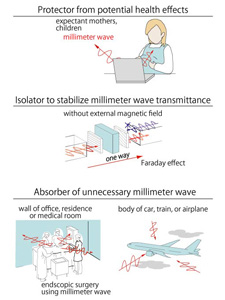
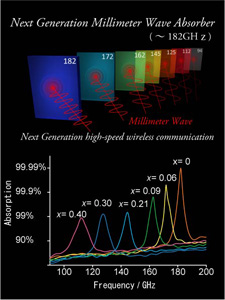
A new and cheap electromagnetic (EM) wave absorber for high-speed wireless communication, which absorbs millimeter wave in the region above 180 GHz was developed. Wireless communication using millimeter wave receives one's attention as a next generation wireless communication system which realizes a fast exchange of huge data such as movie. On the other hand, electromagnetic interference (EMI) is a fatal problem in a wireless communications. To avoid potential health effect from high exposure to EM waves, unnecessary EM waves should be eliminated to protect human bodies, especially expectant mothers and children. Ohkoshi et al. developed a high-performance millimeter wave absorber composed of a series of aluminum-substituted ε-iron oxide, ε-AlxFe2-xO3, nanomagnets (0 ≦ x ≦ 0.66). This materials shows frequency selective EM absorption in the region of 94-182 GHz, depending on chemical composition. ε-AlxFe2-xO3 are metal oxide, therefore they are stable over long periods. Furthermore, because aluminum is the third abundant atom, ε-AlxFe2-xO3 are very economical, and thus, these materials are advantageous for industrial applications. Considerable application of these materials are (1) building materials for a medical room or office, paint on the bodies of a car, train, or airplane as for the prevention of EMI, (2) electronic devices such as isolator or circulator for stabilizing wireless communications.
( A. Namai, et al., J. Am. Chem. Soc., 131, 1170 (2009).)
Please see also "newspaper, No. 80,81"
(5) Ferroelectric ferromagnet
(PLZT)x(BiFeO3)1-x solid solutions ( PLZT : (Pb0.9La0.1)(Zr0.65Ti0.35)O3 ) have been prepared by the solid-state reaction. The materials
for x = 0.10-0.45 showed both magnetic hysteresis loops
and ferroelectric hysteresis loops at room temperature. Moreover,
a film-type of the material has been prepared by a sol-gel method
and MSHG was observed with this film.
(T.Kanai and S. Ohkoshi et al., Adv. Mater., 13, 487 (2001). )

